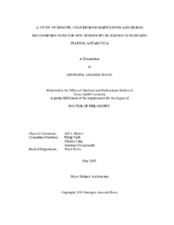| dc.description.abstract | In this dissertation I examine how, despite a very cold, remote location, a holistic approach to the design of a housing facility in McMurdo Station, Antarctica, should simultaneously optimize energy efficiency and occupant comfort and minimize site impact. Because a U.S. scientific presence in Antarctica will continue for the foreseeable future, having a modern, energy efficient station that maximizes human comfort and minimizes human impact on the site is crucial for its scientific mission.
The purpose of this thesis is to provide a new decision tool for the evaluation of architectural and HVAC designs for a McMurdo Station employee habitation that addresses the issues above. This is intended to encourage: 1) increased efficiency of buildings and energy systems, 2) improved quality of life, and 3) reduced environmental impact and enhancement of long-term sustainability by reducing the reliance on fossil fuels. The design tool is based on: 1) a review the station’s architectural, mechanical, and structural evolution up to the present day; 2) an analysis of on-site data collection of current conditions of building interiors; 3) questionnaire responses of contract workers; and 4) energy simulations of selected features of these designs using the energy simulation software DOE-2.1E.
Results showed that: 1) final scores in the matrix indicated the need for a significant improvement in the existing station and the current proposed redesign of the station, which offered many good ideas, but still fell short of an ideal dorm design; and 2) an improved energy simulation showed initial savings of 21% from the application of Energy Efficiency Measures (EEM) based on a modified base case. The matrix provided a useful visual aid that indicated the “push/pull” dynamics” between decisions of design, EEM, and human health and comfort for the unique location and requirements of McMurdo Station. | en |


